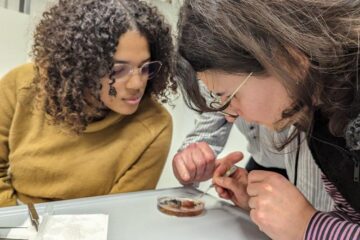Now there is a way to tell the difference between battery laid eggs and free-range or barn

Scientists have developed a method of determining whether eggs labelled as ‘free-range’ or ‘barn’ have in fact been laid under battery conditions. The procedure, published in Journal of the Science of Food & Agriculture this month, means eggs can be tested without the need to visit farms.
The give-away is the dust that the eggs pick up from the surface on which they are laid.
Because the eggs are wet when freshly-laid, the dust attaches to the shell surfaces. The pattern this creates varies according to whether the eggs were laid on cage floors, barn nestboxes or outside. These distinctive patterns can easily be distinguished under ultraviolet light, as the dust fluoresces.
Professor Neville Gregory of the Royal Veterinary College, UK and colleagues in Australia used ultraviolet light to examine the surface patterns on 11520 eggs from cage, barn and free-range production systems.
360 eggs from each of 20 cage, seven barn and five free range units were examined, and categorised according to their dust patterns when exposed to UV light. The type of floor material onto which each egg was laid was known for each farm.
The authors found that the prevalence of white double parallel lines with 2-2.5cm spacing was a distinguishing feature for eggs laid on wire floors in cages.
They conclude that if five or more eggs in a sample of 90 eggs have double fluorescent lines that there is a greater than 999 in 1000 probability that the batch contains some cage-laid eggs.
“The method is effective in distinguishing between free-range eggs and those laid on a wire floor cage,” said Professor Gregory.
“It does not damage the eggs, and can be applied at any stage in the egg marketing chain.”
However, washing the eggs removed or obscured the double lines, so the authors recommend that in countries where egg washing is common, it is best to perform the test before washing.
Distinguishing features in egg shell fluorescence can be used to identify when eggs have been washed, and they can also be used in preliminary screening tests for sun exposure, which in some countries is a cause of runniness of the egg white.
Media Contact
More Information:
http://www.rvc.ac.ukAll latest news from the category: Agricultural and Forestry Science
Newest articles

A new look at the consequences of light pollution
GAME 2024 begins its experiments in eight countries. Can artificial light at night harm marine algae and impair their important functions for coastal ecosystems? This year’s project of the training…

Silicon Carbide Innovation Alliance to drive industrial-scale semiconductor work
Known for its ability to withstand extreme environments and high voltages, silicon carbide (SiC) is a semiconducting material made up of silicon and carbon atoms arranged into crystals that is…

New SPECT/CT technique shows impressive biomarker identification
…offers increased access for prostate cancer patients. A novel SPECT/CT acquisition method can accurately detect radiopharmaceutical biodistribution in a convenient manner for prostate cancer patients, opening the door for more…





















